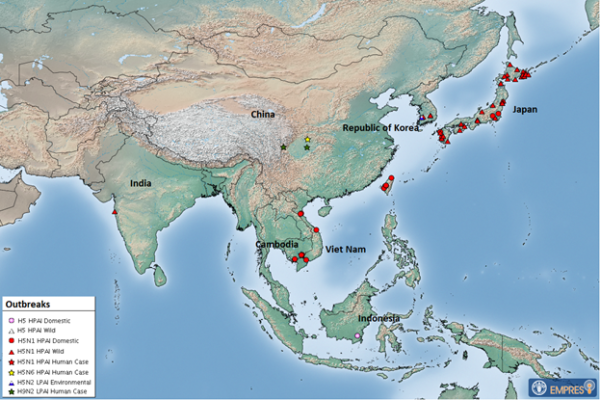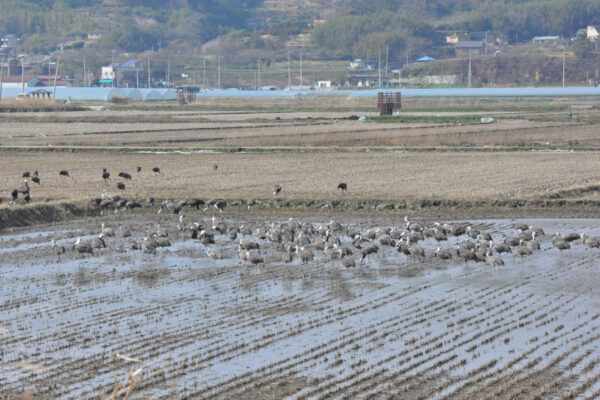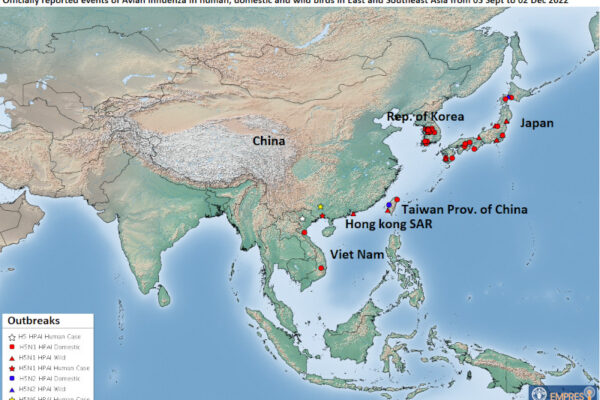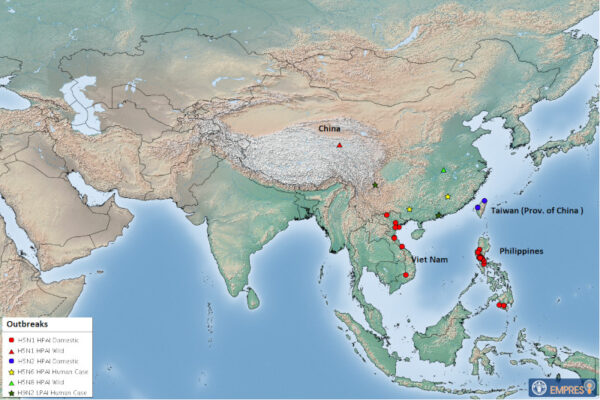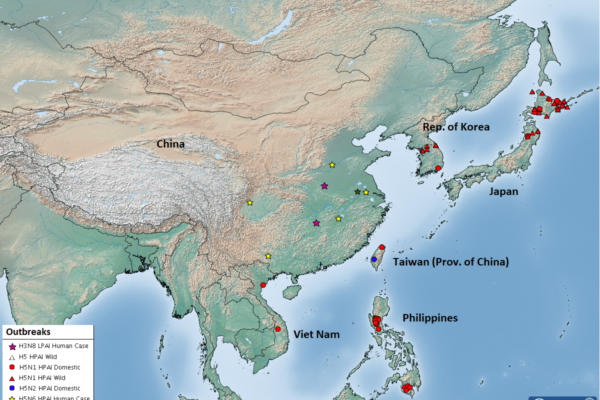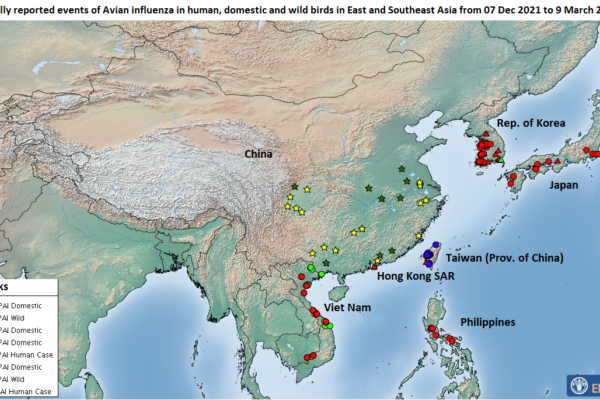-
Updates on Avian Influenza Situation by FAO/EMPRES-AH (Sep 2023 – Dec 2023)
The following article is based on a summary provided by Kamata Akiko from the FAO Animal Production and Health division (NSAH): FAO/EMPRES-AH consistently monitors the global avian influenza situation, gathering information from various national and international sources and peer-reviewed scientific articles. Through close collaboration with country and regional offices, the implementation of avian influenza field surveillance projects, and networks of expertise such as WOAH/FAO’s OFFLU (www.offlu.org), timely information on outbreaks, surveillance findings, and genetic similarities of circulating viruses or their virological features is made accessible. This information is stored in the EMPRES Global Animal Disease Information System (EMPRES-i), a database available online at https://empres-i.apps.fao.org/. Between September 3 and December 2, 2023, three distinct subtypes of avian influenza virus were reported in East and South-East Asia. Among these, only H5N1 or H5 were confirmed to be highly pathogenic in poultry. ©EMPRES-I In September, India reported one H5N1 HPAI event in Black Swans and Silver pheasants in a national park in Maharashtra State. The Republic of Korea reported 39 LPAI events in 8 out of 17 provinces, including 35 H5N3 LPAI, one H5N2 LPAI, and two H5 LPAI events in captured or dead wild birds and their droppings — and since November 27, three H5N1 HPAI events in captured or dead wild birds in North Jeolla and North Gyeongsang provinces, and one H5N1 HPAI outbreak on a duck farm in South Jeolla Province. Since October 4, Japan reported 52 events of H5N1 HPAI in 13 out of 47 prefectures among various bird species (e.g., Anatidae, eastern buzzard, eastern spot-billed duck, Eurasian teal, Eurasian wigeon, hooded crane, large-billed crow, mountain hawk-eagle, peregrine falcon, red-crowned crane, Tundra swan, whooper swan, a captive falcon, and its prey) and environmental samples, including water samples from the Izumi Wintering Habitat of Cranes. Since November 24, four H5N1 HPAI outbreaks in layer chickens in four prefectures. China reported one detection of H5N1 HPAI in environmental samples collected from Sihcao Wetland in Tainan City on November 18, along with five outbreaks of H5N1 HPAI in poultry in Tainan City, Chiayi, Miaoli, Yunlin counties, and one detection at a slaughterhouse in Taipei City in Taiwan Province. Indonesia reported an unspecified subtype of HPAI outbreak during September-October. Viet Nam officially reported HPAI outbreaks in domestic birds in Binh Duong, Long An, and Quang Nam provinces, also detecting H5N1 in two markets in Nghe An Province. In Cambodia, a total of four H5N1 HPAI outbreaks in village poultry were reported in Prey Veng and Svay Rieng provinces in October, and in Kampot Province in November. Meanwhile, three cases of human infection with influenza A(H5N1) virus were reported from Cambodia in Prey Veng and Svay Rieng provinces in October and Kampot Province in November. China also reported one case of A(H5N6) in Chongqing in September and one case of A(H9N2) in Sichuan in October. Highly pathogenic H5Nx viruses have demonstrated the ability to spread via migratory water birds. During this period, H5N1 HPAI events have also been reported in wild birds near Antarctica, namely among brown skua in South Georgia and the South Sandwich Islands, and southern fulmar and black-browed albatross in the Falkland Islands (Malvinas). We consider avian influenza activity in the East Asia flyway area to have increased during this period, so reports of outbreaks in poultry and detections in wild birds and some mammal species are expected to increase over the coming months in the region. The list of bird species affected by H5Nx HPAI globally is available HERE with the new species reported since 2021 highlighted in orange.
Continue reading -
Updates of Worldwide Avian Influenza Situation by FAO/EMPRES-AH (Dec 2022 – June 2023)
FAO/EMPRES-AH is constantly monitoring the avian influenza situation worldwide and compiles information from multiple national and international sources as well as peer-reviewed scientific articles. In close collaboration with country and regional offices, the implementation of avian influenza field surveillance projects, and networks of expertise like WOAH/FAO’s OFFLU (www.offlu.org) provide access to timely information on outbreaks, surveillance findings, and genetic similarities of circulating viruses or their virological features. This information is stored in the EMPRES Global Animal Disease Information System (EMPRES-i), a database that can be accessed online at https://empres-i.apps.fao.org/. Avian Influenza in East and Southeast Asia from December 2022 to June 2023 ©EMPRES-I During the period of 3 December to 2 June 2023, six highly pathogenic avian influenza (HPAI) virus subtypes (H5, H5N1, H5N2, H5N5, H5N6, and H5N8) and five low pathogenic avian influenzas (LPAI) virus subtypes (H3N8, H5N2, H7N7, H7N3, and H9N2) have been reported detected in Eastern and South-eastern Asia. H5Nx HPAI viruses continue to circulate in Eastern and South-eastern Asia and reported detections increased since the last report. Within the reporting period, HPAI outbreaks occurred in Cambodia which reported an H5N1 detection in an unspecified wild bird in Prey Veng province caused by the clade 2.3.2.1c. Japan reported HPAI H5, H5N1, and H5N8 affecting numerous species of captive and wild birds including Crane, Crow, Swan, Goshawk, Mallard, Flacon, Eagle, Heron, Buzzard, Owl, Spoonbill, Scaup, Goose, Duck, and Jay as well as outbreaks in poultry caused by H5N1 and H5N2 subtypes leading to the culling of over 14 million birds in 32 provinces. In the Republic of Korea, there were reports of 70 H5N1 outbreaks of clade 2.3.4.4b which affected nearly 4 million domestic poultry in the regions of Chollanam-do, Chungcheongnam-do, Chungchongbuk-do, Gangwon-do, Gyeonggi-do, Gyeongsangbuk-do, Jeollabuk-do, Jeollanam-do, Kyongsangnam-do, Kyonggi-do and Kyongsangbuk-do. Indonesia reported one poultry outbreak caused by the H5N1 clade 2.3.4.4b in Kalimantan Selatan affecting 4430 ducks. Clade 2.3.2.1e viruses have been detected in West Java, Central Java, and Lampung Riau provinces. Viet Nam officially reported nine poultry outbreaks in Cao Bang, Dong Nam, Nghe An, Ninh Binh Quand Ngai, and Quang Ninh provinces affecting 4192 out of 4200 ducks and unspecified birds In China, Taiwan Province reported 66 poultry outbreaks caused by H5Nx, H5N1, H5N2, and H5N5 subtypes that lead to the destruction of over 1 million domestic poultry. Wild birds were affected by the H5, H5N1 subtypes affecting Eurasian teal, Black-faced spoonbill, Gull-billed tern, and Whiskered terns. One H5N1 HPAI detection was reported in Hong Kong SAR, China in Black-faced spoonbill. Outbreaks in poultry caused by low pathogenic subtypes included H9N2 reported in Taiwan, the Province of China, and the H7N7 and H7N3 low pathogenic subtypes were detected in environmental samples. In addition to outbreaks in avian species: A(H5N1) was reported in a fox in Japan in April 2023. In the last update, Viet Nam reported one influenza A(H5) human infection in a 5-year-old female who had exposure to backyard poultry and ducks; the subtype has now been confirmed as A(H5N1). Since the last update A(H3N8) has been reported in Guangdong Provence in China in a 56-year-old female and A(H5N6) in a 49-year-old male. Two clades 2.3.2.1c A(H5N1) cases were reported in Cambodia in an 11-year-old girl (fatal) and her father (mild illness). In Anhui province, one clade 2.3.4.4b A(H5N1) human infection was reported in a 53-year-old female. 5 human cases of A(H9N2) were reported in children in the Hunan (3), Jiangxi (1) and Sichuan (1) provinces. Most of these cases reported exposure to backyard poultry and any human-to-human transmission has been ruled out. Since 2014 (as of 3 June 2023), there have been 83 human cases of influenza A(H5N6) have been reported, 82 occurring in China and one in Lao People's Democratic Republic with the most recent case reported on 2 February 2023 with an onset of disease on 17 December 2022 in China. Both the clade 2.3.2.1c and the clade 2.3.4.4b A(H5N1) have caused disease in humans since 2020. The most recent reports of each had an onset of 23 February 2023 and 31 January 2023 respectively. To date 116 influenza A(H9N2) human cases have been reported worldwide with at least 96 cases reported in China since December 2015. The most recent case was reported on 9 March 2023 with an onset date of 5 February 2023 in China. Highly pathogenic Goose/Guangdong lineage clade 2.3.4.4b H5Nx viruses have demonstrated the ability to spread long distances via migratory water birds. These viruses are continuing to infect an increasing range of wild bird species. This has led to an increase in infections reported in mammalian species which often display neurological symptoms. Globally the impacts on ecologically important birds, such as seabirds have been increasingly noted and are implicated in spread. Asia has experienced repeated incursions of the virus from multiple directions as well as circulation. We expect avian influenza activity to maintain in Asia. Reports of outbreaks in poultry, detections in wild birds and occasional detections in mammalian species are expected to continue in the region over the coming months. Please click [here] to view a larger version of the table above
Continue reading -
Updates of HPAI recorded in East Asian – Australasian Flyway
Since November 2021, a series of unprecedent outbreaks of HPAI (Highly Pathogenic Avian Influenza) occurred in western Eurasia and depleted significant percentages of waterbirds and seabird populations: Barnacle Goose in Scotland, Eurasian Crane in Israel, Dalmatian Pelican in southeastern Balkans and seabirds along the coast of the Atlantic Ocean. However, no significant incidents were reported from the East Asian-Australasian Flyway except die-offs of several hundred seabirds, such as Tufted Puffins and Rhinoceros Auklets, recorded around the waters of Kunashir Islands in southern Kuril in August 2022, which no official evidence of an HPAI outbreak was indicated by the time of writing. Yet, outbreaks of HPAI was recorded in cranes and other migratory waterbirds in the EAA Flyway in recent two months. Hooded Cranes in Suncheon Bay © Suncheon City On 1 November 2022, a Hooded Crane was found dead at Izumi, Japan and about one week later it was confirmed to be HPAI positive. Numbers of dead birds escalated since, reaching a daily peak of 74 dead Hooded Cranes collected on 17 November. Dead White-naped Cranes were recorded starting on 14 November. The number of daily totals of dead cranes decreased to less than 15 carcasses found from 8 December. As of 23 December 2022, the total number of carcasses of Hooded Cranes collected at Izumi were at least 1,097 and White-naped Crane at least 47. Three Hooded Crane carcasses testing positive of HPAI were collected from Kyushu: 2 from Isahaya and 1 from Akune (Information from the website of Ministry of the Environment Japan, link). Movements of cranes departing from Izumi, Japan were observed from late November. At the same time, there was a surge in the number of Hooded Cranes wintering at Suncheon, Ro Korea. It was speculated some cranes moved from Izumi to wintering sites in Ro Korea. This was proven by Hooded Cranes tracked by Dr Li Xianda in China (from Izumi, Japan to Chonsu Bay, Ro Korea in late November 2022). However, such movement is not irregular as Dr Li’s tagged Hooded Cranes were also recorded travelling between wintering sites in Japan and Ro Korea in 2020 and 2021 (Per. comm. from Li Xianda to Simba Chan). The number of Hooded Cranes at Suncheon reached a peak of several thousand birds in late November but started to decrease to about 3,500 birds in early December. It is believed cranes moved to Chonsu Bay and Galsa Bay, other wintering sites of Hooded Cranes in Ro Korea. The first dead Hooded Crane was found at Suncheon on 13 November. As of 12 December, 158 dead Hooded Cranes and one dead White-naped Crane were found in Ro Korea. On 20 November one sick Red-crowned Crane was captured in Kushiro, Japan and it was tested HPAI positive one week later. However, this should be seen as an independent case of HPAI from the wintering grounds in western Japan. In response to the HPAI outbreak, the Crane Working Group of the EAAFP held an emergency zoom meeting on 12 December and a proposal for reactions to the HPAI in the EAAF region was submitted to the EAAFP Secretariat. The Crane Working Group also sent warnings to other crane wintering sites. So far no abnormal crane deaths has been reported from China and the wintering sites were advised not to artificially feed cranes to avoid concentrations of cranes and other wintering birds. The Crane Working Group has also contacted crane researchers in Israel on possible links between the present incident and the HPAI outbreak at Hula Valley in December 2021, in which about 8,000 Eurasian Cranes died. Advice from Israeli colleagues was to remove crane carcasses especially those in water as quickly as possible and also avoid artificial feeding that would result in concentration of birds. In late November to early December, 34 dead Oriental Storks were found near Tianjin, at the coast of Bohai, China. Poisoning from poachers and HPAI have been ruled out and the cause of death is still under investigation. On 24 November and 12 December, dead Black-faced Spoonbills were found at Mai Po Nature Reserve and Hong Kong Wetland Park in Hong Kong S.A.R. respectively, were confirmed to be HPAI positive. On 9 December another dead Black-faced Spoonbill collected at Kumamoto Prefecture, Japan was also found to be HPAI positive. It is speculated more birds may have died during migration but were not found or reported. At the time when this news release was written, catastrophic HPAI outbreaks are occurring in Latin America, particularly along the coast of Peru where more than 20,000 dead seabirds (majority Peruvian Pelicans) recorded. The massive outbreaks of HPAI that started in western Eurasia in late 2021 are now being recorded in the East Asian Australasian Flyway. The Crane Working Group contacted other species working groups and task forces and almost all agreed on actions that should be taken as soon as possible. While we proposed strategies to be discussed at meetings in 2023, we also urge managers and local stakeholders at important waterbird/seabird sites to take precautions as suggested below, and countries along the flyway should keep in close communication on new cases of outbreaks. Recommendation to important waterbird/seabird sites: Have at least one staff member in charge of biosecurity. Have a contingency plan following the guidance of national authorities in case of outbreak of avian influenza and other avian diseases. Ideally the plan will be rehearsed every year before migratory seasons so staff and volunteers of the site understand all procedures and their roles in case of emergency. Have a contact list of agencies and institutions that can provide support during an outbreak. Have regular monitoring and surveillance on wild birds, particularly when outbreaks are reported along the flyway. In case sick and/or dead birds are found, try to collect them without causing disturbance to other birds. Although the risk of HPAI transmitting to human is low, personal protective equipment has to be used when handling sick or dead birds and the methods of collection and handling should follow national guidelines. Photographing the dead bird for records and to identify the species and gender. Useful references: 2007. Wild Birds and Avian Influenza: an introduction to applied field research and disease sampling techniques. Edited by D. Whitworth, S.H. Newman, T. Mundkur and P. Harris. FAO Animal Production and Health Manual, No. 5. Rome. (download from here) CMS Scientific Task Force on Avian Influenza and Wild Birds Issues Recommendations (2022) (visit the webpage here). Hacen Mohamed El-Hacen. 2022. Workshop report: Development and consequences of the recent bird flu outbreak among Sandwich terns in the Wadden Sea and adjacent areas (download from here) Scientific Task Force on Avian Influenza and Wild Birds statement on: H5N1 Highly Pathogenic Avian Influenza in poultry and wild birds: Winter of 2021/2022 with focus on mass mortality of wild birds in UK and Israel (2022) (download from here) Wildlife Health Australia (2021) The sixth issue Wild Bird News June 2021 - National Avian Influenza Wild Bird Surveillance Newsletter (download from here) More references and useful links are available on webpage of Avian Influenza Working Group (link), News links: Ministry of the Environment, Japan: 高病原性鳥インフルエンザに関する情報 | 自然環境・生物多様性 | 環境省 (env.go.jp) News about dead seabirds washed to Kunashir Islands in southern Kuril (available on 12 August, 2022, visit the webpage here) Article prepared by Crane Working Group.
Continue reading -
Updates of Worldwide Avian Influenza Situation by FAO/EMPRES-AH (Sept 2022 – Dec 2022)
FAO/EMPRES-AH is constantly monitoring the avian influenza situation worldwide and compiles information from multiple national and international sources as well as peer-reviewed scientific articles. Close collaboration with country and…
Continue reading -
Updates of Worldwide Avian Influenza Situation by FAO/EMPRES-AH (Jun 2022 – Sept 2022)
FAO/EMPRES-AH is constantly monitoring the avian influenza situation worldwide and compiles information from multiple national and international sources as well as peer-reviewed scientific articles. Close collaboration with country and…
Continue reading -
Updates of worldwide Avian Influenza situation by FAO/EMPRES-AH (Mar 2022 – Jun 2022)
FAO/EMPRES-AH is constantly monitoring the avian influenza situation worldwide and compiles information from multiple national and international sources as well as peer-reviewed scientific articles. Close collaboration with country and…
Continue reading -
Updates of worldwide avian influenza situation by FAO/EMPRES-AH (Dec 2021 – Mar 2022)
FAO/EMPRES-AH is constantly monitoring the avian influenza situation worldwide and compiles information from multiple national and international sources as well as peer-reviewed scientific articles. Close collaboration with country and…
Continue reading
- 1
- 2


